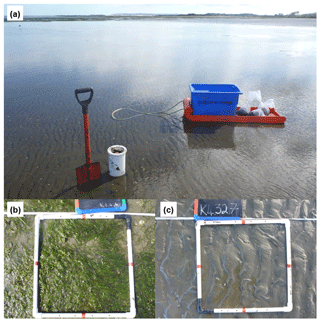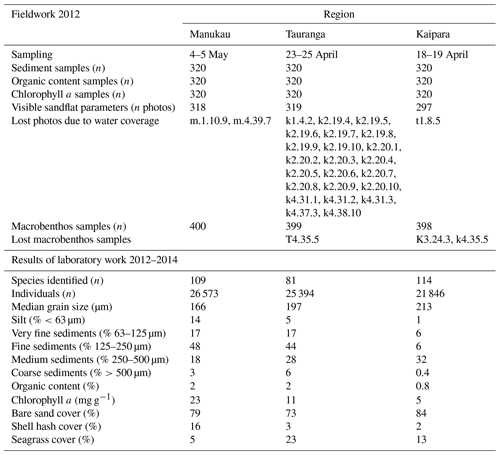Araújo, M. B. and Luoto, M.: The importance of biotic interactions for
modelling species distributions under climate change, Global Ecol.
Biogeogr., 16, 743–753, https://doi.org/10.1111/j.1466-8238.2007.00359.x,
2007.
Dormann, C. F., Bobrowski, M., Dehling, D. M., Harris, D. J., Hartig, F.,
Lischke, H., Moretti, M., Pagel, J., Pinkert, S., Schleuning, M., Schmidt,
S. I., Sheppard, C. S., Steinbauer, M. J., Zeuss, D., and Kraan, C.: Biotic
interactions in species distribution modelling: ten questions to guide
interpretation and avoid false conclusions, Global Ecol. Biogeogr., 27,
1004–1016, https://doi.org/10.1111/geb.12759, 2018.
Douglas, E. J., Pilditch, C. A., Kraan, C., Schipper, L. A., Lohrer, A. M.,
and Thrush, S. F.: Macrofaunal functional biodiversity provides resilience
to nutrient enrichment in coastal sediments, Ecosystems, 7, 1324–1336,
https://doi.org/10.1007/s10021-017-0113-4, 2017.
Greenfield, B. L., Kraan, C., Pilditch, C. A., and Thrush, S. F.: Mapping
functional groups can provide insight into ecosystem functioning and
potential resilience of intertidal sand flats, Mar. Ecol.-Prog. Ser., 548,
1–10, https://doi.org/10.3354/meps11692, 2016.
Hewitt, J. E. and Thrush, S. F.: Reconciling the influence of global climate
phenomena on macrofaunal temporal dynamics at a variety of spatial scales,
Glob. Change Biol., 15, 1911–1929,
https://doi.org/10.1111/j.1365-2486.2008.01825.x, 2009.
Kohler, K. E. and Gill, S. M.: Coral Point Count with Excel extensions
(CPCe): A Visual Basic program for the determination of coral and substrate
coverage using random point count methodology, Comput. Geosci., 32,
1259–1269, https://doi.org/10.1016/j.cageo.2005.11.009, 2006.
Kraan, C., van Gils, J. A., Spaans, B., Dekinga, A., Bijleveld, A. I., van
Roomen, M., Kleefstra, R., and Piersma, T.: Landscape-scale experiment
demonstrates that Wadden Sea intertidal flats are used to capacity by
molluscivore migrant shorebirds, J. Anim. Ecol., 78, 1259–1268,
https://doi.org/10.1111/j.1365-2656.2009.01564.x, 2009.
Kraan, C., Aarts, G., van der Meer, J., and Piersma, T.: The role of
environmental variables in structuring landscape-scale species distributions
in seafloor habitats, Ecology, 91, 1583–1590,
https://doi.org/10.1890/09-2040.1, 2010.
Kraan, C., Aarts, G., Piersma, T., and Dormann, C. F.: Temporal variability
of ecological niches: a study on intertidal benthic fauna, Oikos, 122,
754–760, https://doi.org/10.1111/j.1600-0706.2012.20418.x, 2013.
Kraan, C., Dormann, C. F., Greenfield, B. L., and Thrush, S. F.: Cross-scale
variation in biodiversity-environment links illustrated by coastal sandflat
communities, PLoS ONE, 10, e0142411,
https://doi.org/10.1371/journal.pone.0142411, 2015.
Kraan, C., Greenfield, B. L., and Thrush, S. F.: Multi-scale data on
intertidal macrobenthic biodiversity and environmental features in three New
Zealand harbours, PANGAEA, https://doi.org/10.1594/PANGAEA.903448, 2019.
Lohrer, A. M., Thrush, S. F., Hewitt, J. E., and Kraan, C.: The up-scaling of
ecosystem functions in a heterogeneous world, Sci. Rep.-UK, 5, 10349,
https://doi.org/10.1038/srep10349, 2015.
Thrush, S. F., Hewitt, J. E., Norkko, A., Nicholls, P. E., Funnell, G. A.,
and Ellis, J. I.: Habitat change in estuaries: predicting broad-scale
responses of intertidal macrofauna to sediment mud content, Mar. Ecol.-Prog. Ser., 263, 101–112, https://doi.org/10.3354/meps263101, 2003.
Thrush, S. F., Hewitt, J. E., Kraan, C., Lohrer, A. M., Pilditch, A. M., and
Douglas, E. J.: Changes in the location of biodiversity-ecosystem function
hot spots across the seafloor landscape with increasing sediment nutrient
loading, P. Roy. Soc. Lond. B Bio., 284, 20162861,
https://doi.org/10.1098/rspb.2016.2861, 2017.






